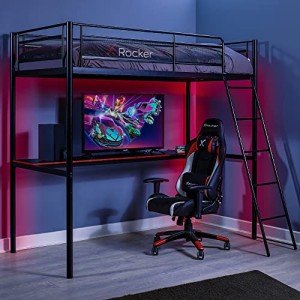The 3 Greatest Moments In Bunk Beds History
Exploring Bunk Beds: A Comprehensive Guide
Bunk beds have long been a staple in kids's bedrooms, dorms, and even homes with minimal space. Not only do they supply a useful sleeping solution, however they likewise create a fun and creative environment for children and a great space-saver for adults and households. This post will check out everything you need to learn about bunk beds, from types and materials to safety suggestions and buying recommendations.
Tabulation
- Kinds Of Bunk Beds
- Conventional Bunk Beds
- Loft Beds
- Triple Bunk Beds
- L-Shaped Bunk Beds
- Product Options
- Wood
- Metal
- Safety Considerations
- Purchasing Guide
- Frequently asked questions
Kinds Of Bunk Beds
Bunk beds are available in numerous styles to suit various needs and preferences. Here's a breakdown of the most typical types:
Conventional Bunk Beds
Standard bunks normally feature 2 beds stacked vertically on top of one another. These beds are perfect for brother or sisters sharing a room or for taking full advantage of sleeping space in guest rooms.
Loft Beds
Loft beds stand similarly to standard bunk beds however do not have a lower sleeping area. Rather, they often incorporate a desk or seating location below, making them a great option for small spaces needing multifunctionality.
Triple Bunk Beds
Triple bunk beds are developed for three residents, with beds stacked in a three-tier setup. These are less common but can be a fun solution for large households or slumber parties.
L-Shaped Bunk Beds
With one bed placed horizontally and the other vertically, L-shaped bunk beds are typically equipped with extra features such as desks or storage drawers and can complement corner areas in a room.
Contrast of Bunk Bed Types
Bed Type
Suitable Use
Description
Standard
Shared bed rooms or visitor rooms
Two beds stacked vertically
Loft
Little spaces needing multi-purpose space
Upper bed with open space below
Triple
Big families or pajama parties
Three beds stacked vertically
L-Shaped
Corner or flexible areas
A mix of vertical and horizontal beds
Material Options
Bunk beds are produced from numerous materials, with wood and metal being the most typical. Each product has its benefits and drawbacks.
Wood
- Sturdiness: Generally robust and can withstand years of use.
- Visual Appeal: Offers a traditional appearance that can mix with various decorations.
- Weight Capacity: Typically tougher; can support much heavier weights.
- Downsides: May be more pricey than metal options and can be vulnerable to scratches.
Metal
- Sturdiness: Generally light-weight and simple to move however still tough.
- Modern Design: Often can be found in streamlined styles, making it appealing for contemporary areas.
- Economical: Usually less costly than wood options.
- Disadvantages: Can be cold to the touch in winter seasons and might not have the very same visual appeal for some purchasers.
Security Considerations
When it comes to bunk beds, security can not be ignored. Here are crucial security tips to remember:
- Guardrails: Ensure that the leading bunk has guardrails on both sides to avoid falls.
- Strong Construction: Check for a strong construct and tough products to withstand weight and movement.
- Weight Limit: Adhere to the manufacturer's weight limit for both the upper and lower bunks.
- Ladder Design: Choose bunks with a safe, easy-to-climb ladder and avoid any sharp edges or rungs.
- Age Restrictions: Most manufacturers suggest that kids under the age of 6 ought to not oversleep the upper bunk.
Buying Guide
When looking for bunk beds, consider the list below aspects to find the very best fit for your needs:
- Space Availability: Measure the room size and ceiling height, making sure there is sufficient space for the top bunk.
- Bed Size: Decide between twin, complete, or larger sizes based upon your needs and the size of the space.
- Design Preference: Consider the general design of the bedroom to find an appropriate design.
- Reduce of Setup: Look for a bunk bed that is straightforward to put together.
- Budget plan: Bunk beds come in different price ranges, so determine a budget plan before starting your search.
Frequently asked questions
1. What is the recommended age for kids to sleep on the leading bunk?
Children aged six and older are generally recommended to sleep on the top bunk to decrease the risk of falls.
2. How can I make my bunk bed much safer?
To enhance safety, ensure guardrails are appropriately installed and examine that the bed is put on a flat surface area. Furthermore, encourage kids to use the ladder thoroughly.
3. Can I transform a bunk bed into 2 different beds?
Lots of bunk beds are created to be convertible. Inspect the maker's requirements for convertibility functions.
4. What devices are readily available for bunk beds?
Typical accessories consist of bed linens, storage drawers, staircases rather of ladders, and tented canopies for an enjoyable visual appeal.
5. How do I preserve my bunk bed?
Regular checks for loose screws or structural integrity can assist make sure security. Dust the bed routinely and tidy spills promptly to keep the materials in good condition.
Bunk beds are versatile and a space-efficient service for different living circumstances, from kids's spaces to guest lodgings. With lots of designs and materials readily available, prospective buyers have a wealth of alternatives to think about, ensuring a mix of practicality and aesthetic appeals. By focusing on Bunk Beds House rickynunez.top and following the suggestions described in this guide, people can discover the ideal bunk bed that suits their space and way of life, all while producing an enjoyable sleeping environment.
